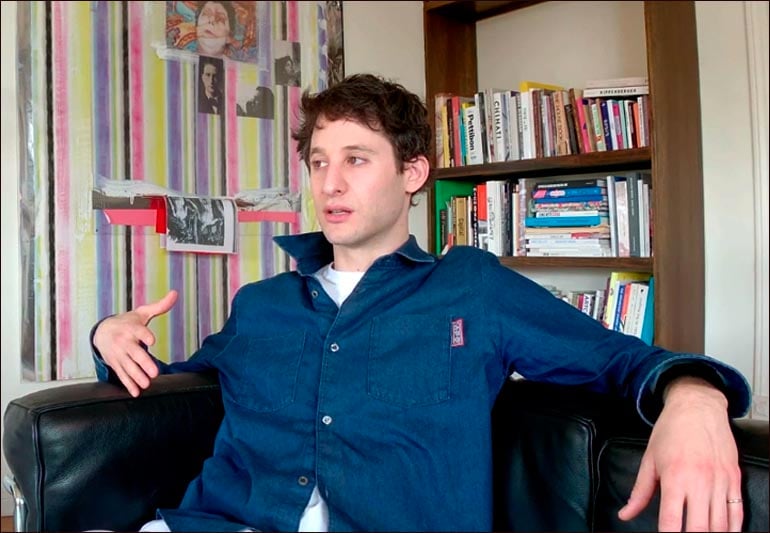
Whether you adore him or abhor him, see him as a prescient genius or a privileged dirtbag, there’s virtually no middle ground when it comes to artist Jordan Wolfson.
“He just struck me as such a great character study,” says James Crump, director of the new documentary “Spit Earth: Who is Jordan Wolfson?” on why he chose the polarizing artist as his latest subject.
The hour-long film, which will make its streaming debut this Friday on Vimeo, doesn’t offer a clear answer, but it does feature some notable names willing to weigh in with their own two cents on the artist, including critic and curator Jack Bankowsky, art historian Andrianna Campbell-LaFleur, and Fear of Flying author Eric Jong, who also happens to be Wolfson’s aunt-in-law.
“He’s a psycho. He’s a monster,” says Stefan Kalmár, director of the Institute of Contemporary Arts, London, while recalling a fund-raising video Wolfson once made. “It’s like a short YouTube movie someone posts before he goes on a shooting rampage. It’s scary.”
“He’s a lost person, I think,” says Emma Fernberger, a director at Galerie Eva Presenhuber and an ex of Wolfson’s.
Produced by art historian and collector Ronnie Sassoon, with whom Crump had previously collaborated on a 2017 film about fashion illustrator Antonio Lopez, Spit Earth charts the trajectory of Wolfson’s work, from the attention-grabbing videos of his early career to the animatronic sculptures of the mid-2010s that propelled him to art world infamy, and beyond.
The film aims to unpack the psychology of the artist whose own output—with its distinct melange of Freudian themes (repressed trauma, psychosexual expression, and gender identity, to name a few)—makes armchair analysts of us all. It positions Wolfson as an enfant terrible of the Trump-era art world, an artist who very easily could be—but so far hasn’t been—”canceled,” and who embodies a nagging intellectual question of our day: Can you separate the artist from his work?
“I felt that Jordan was a perfect foil to the contemporary art world at this particular moment,” says Crump. “To me, he’s both a product and a symptom of the conditions of today’s out-of-control, hyper-speculative art market.” In Wolfson’s work, Crump adds, “the elements of spectacle and celebrity and conspicuous consumption all converge in a way to put up a mirror to this money-driven field.”
Dealer Jeffrey Deitch discussing Wolfson’s work in Spit Earth: Who is Jordan Wolfson?
Though the film is not shy in its praise of the artist, it’s also not an especially flattering portrait either. Campbell-LaFleur recalls punching Wolfson after he made a pass at her (though she later said the account was taken out of context); Fernberger tells a story of how after she and Wolfson broke up she was shocked to discover a nude image of herself in one of his artworks at a museum. “It was just really mean,” she says in the film. (She has since said that it was shown with her consent.)
And through direct juxtapositions of footage, Wolfson is compared, at various points, to both Jeff Koons at his most narcissistic and Patrick Bateman from American Psycho.
“All I’ve ever wanted is to make great art and bring awareness,” Wolfson told Artnet News in a statement. “I’ve not seen the final cut of the film so I don’t know if the director has accurately portrayed that. I wish the filmmaker the best of luck.”
Wolfson’s candid interviews may do little to assuage his critics as well. “I sense that Jordan himself may regret some of the things he said to us on camera,” Crump says when asked how Wolfson responded to seeing a rough draft of the film for the first time. “Looking into that mirror is a real shock to anyone. I think it was a particular shock to Jordan.”
“Though Jordan signed off on the project before filming began and fully participated in its making—to the extent that his parents and ex-girlfriend have major roles—he has since repudiated the searing psychological portrait that resulted,” Kenny Schachter, one of the talking heads in the film, wrote in a recent column.
Jordan Wolfson, Colored sculpture (2016). Courtesy of Sadie Coles HQ and David Zwirner.
“I still believe he’s a brilliant person,” says Crump. “He’s incredibly complex. There are things that have been said about him that are very damning but true.” He adds: “I still think he’s among the leading artists of our day.”
Spit Earth: Who is Jordan Wolfson? will be available to stream on Vimeo Friday, May 1, and on Amazon Prime in the coming months.